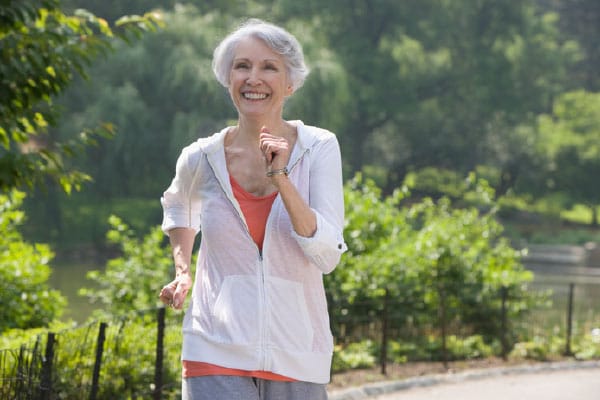The human body is amazingly complex. With nearly a dozen systems working in symphony with one another, each is vitally important to a person’s overall health. The skeletal system is comprised of 206 bones and performs six major functions in the body: support, movement, protection, production of blood cells, storage of minerals, and endocrine regulation.
Osteoporosis is a disease that can impact the skeletal system, causing bones to become weak or brittle, putting people at risk for fractures. Bone is living tissue that is constantly being broken down and replaced. When a person is young, bone is made faster than it is broken down. As people age, this process slows and bone mass is lost faster than it’s created. Osteoporosis occurs when the creation of new bone is unable to keep up with the loss of old bone.
At American, Advocate and Whitsyms In-Home Care, we know that keeping bones healthy is an important part of helping older adults live independently. To better understand the risk factors, as well as osteoporosis prevention strategies, we share the following helpful information.
Who Is at Risk for Osteoporosis?
Osteoporosis can affect both women and men, and while it can develop at any age, the risk factors increase as a person ages. In women, the disease may begin to develop a year or two prior to menopause. Although most common in non-Hispanic white and Asian women, osteoporosis can develop in men and in African American and Hispanic individuals of both sexes. Additional risk factors include:
- Body frame size. Women and men who have small body frames are typically at higher risk as they have less bone mass to draw from as they age.
Family history. Having a parent or sibling with osteoporosis puts an individual at greater risk. - Thyroid issues. Too much thyroid hormone can cause bone loss. This can occur if a person’s thyroid is overactive or if too much thyroid hormone medication is taken to treat an underactive thyroid.
- Sex hormones. Lowered sex hormone levels can be a strong contributing factor for osteoporosis. Decreased estrogen levels following menopause, treatments for prostate cancer that reduce testosterone levels in men, and treatments for breast cancer that reduce estrogen levels in women are likely to accelerate bone loss.
- Low calcium intake. Long-term lack of calcium in a person’s diet plays a role in the development of osteoporosis and can contribute to diminished bone density, early bone loss, and an increased risk of fractures.
- Steroids and other medications. Long-term use of oral or injected corticosteroid medications, such as prednisone and cortisone, interferes with the bone-rebuilding process. Additionally, medications for gastric reflux, transplant rejection, and seizures can increase bone loss and the risk for osteoporosis.
- Sedentary lifestyle. People who spend large amounts of time sitting have a higher risk of osteoporosis than individuals who are more active.
- Tobacco use. While the exact role tobacco plays in osteoporosis is not clear, it has been shown to contribute to weak bones.
- Chronic heavy drinking. Long-term consumption of more than two alcoholic drinks per day increases the risk of osteoporosis.
Osteoporosis Prevention
While a number of osteoporosis risk factors are out of a person’s control, lifestyle changes can help maintain bone health.
Calcium.
Men and women between the ages of 18 and 50 need 1,000 milligrams of calcium per day. This daily amount increases to 1,200 milligrams when women turn 50 and men turn 70. To increase calcium intake, consider including these foods as part of a well-rounded diet:
- Calcium-fortified cereals and orange juice
- Low-fat dairy products
- Dark green leafy vegetables
- Canned salmon or sardines with bones
- Soy products, such as tofu
If it is difficult to reach the recommended daily intake of calcium through diet alone, speak with your physician about including an over-the-counter calcium supplement.
Vitamin D.
Vitamin D helps improve the body's ability to absorb calcium. People can get vitamin D from sunlight; however, the use of sunscreen reduces the amount of vitamin D absorbed this way. It is recommended that people get at least 600 international units (IU) of vitamin D per day. After a person turns 70 years old, that recommendation increases to 800 IU per day. Vitamin D can be found in:
- Trout, salmon, tuna and swordfish
- Orange juice fortified with vitamin D
- Dairy and plant milks fortified with vitamin D
- Egg yolks
- Fortified cereals
If you have trouble getting enough vitamin D in your diet, speak with your health care provider to determine the type and amount of vitamin D supplements you should take.
Exercise.
Exercise helps build strong bones and slow bone loss, and provides benefits no matter when you start. For maximum benefits, combine strength training exercises with weight-bearing and balance exercises.
- Strength training helps strengthen muscles and bones in the arms and upper spine.
- Weight-bearing exercises such as walking or jogging strengthen the bones in the legs, hips and lower spine.
- Balance exercises such as tai chi help to reduce the risk of falling.
At American, Advocate and Whitsyms In-Home Care, our referred care providers help older adults make healthy lifestyle choices by encouraging regular, physician-approved exercise, healthy eating habits and much more. These care providers can work with each client to offer a variety of in-home care services that enhance independence and safety, while helping to monitor conditions such as osteoporosis and other chronic health conditions.
Contact us today at the location nearest you and let us help find the perfect care provider to meet your needs.
- American In-Home Care – Serving North, Central, and West Coast of Florida
- Advocate In-Home Care – Serving Southeast and Southwest Florida
- Whitsyms In-Home Care – Serving Southeast and Southwest Florida
State of Florida License and Registration Numbers: 30211518, 30211651, 30211295, 30211390, 30210978, 30211293, 30211382, 30211504, 30211733, 30211535, 30211531, 30211710, 30211709, 30211045, 5661


